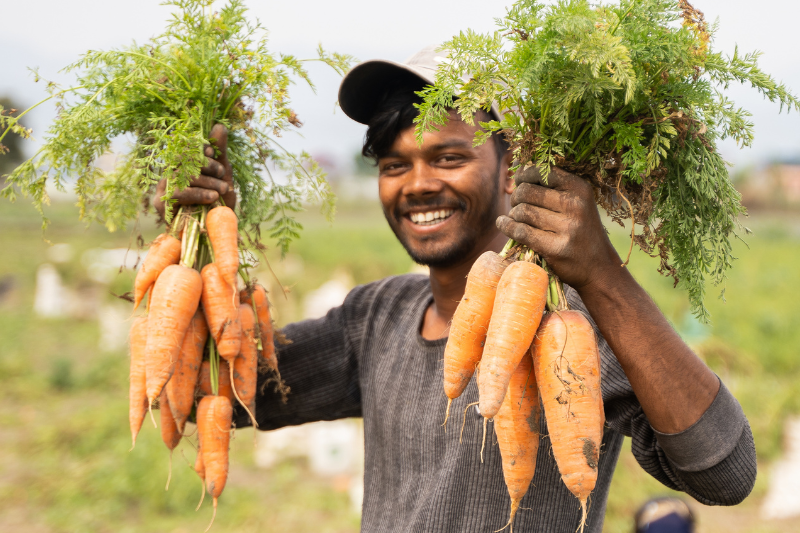
By Christina Frank
The production of safe fruits and vegetables requires farmers to manage potential sources of foodborne pathogens, from keeping uncomposted or raw manure out of fields where crops are being sown to washing produce in clean, uncontaminated water at harvest. In Nepal, demand for fresh produce has been rising due to an increased awareness of its nutritional benefits. Growers and extension agents now have a new resource to understand the risks and steps they can take to safeguard fruits and vegetables: a grower’s manual created by a project funded by the Feed the Future Innovation Lab for Food Safety.
Safeguarding fruits and vegetables from foodborne pathogens can seem like a daunting proposition. Contamination can occur at any stage from farm to table—from sources including animal feces in the field, irrigation and wash water, harvesting containers, or infected workers—and it can lead to serious foodborne illnesses.
“Improper handling and contamination of fresh produce by pathogens can lead to outbreaks of diseases such as cholera, typhoid, and various forms of bacterial infections,” said lead author Agnes Kilonzo-Nthenge, research professor in the Department of Food and Animal Sciences at Tennessee State University (TSU). Common pathogens found in raw produce include bacteria such as E. coli, Salmonella, Listeria, and Campylobacter, as well as mold-causing fungi, parasites, and viruses such as norovirus, rotavirus, and the hepatitis A virus.
The manual explains that fruits and vegetables consumed raw can pose a higher food safety risk since they don’t undergo a “kill step” during cooking that would inactivate microbial pathogens. Root crops such as onions, carrots, and beets—in which the edible portions of the crop are in direct contact with soil— as well as lettuce, spinach, papaya, mango, and mushrooms are among the fruits and vegetables most likely to carry pathogens if not properly handled.
In response to produce growers’ and extension workers’ requests for guidance on food safety practices to improve the quality and marketability of their produce, the project convened a group of subject matter experts to establish a Food Safety Working Group in Nepal. In April, the first copies of their manual, entitled “Fresh Produce Safety and Good Agricultural Practices for Produce Growers in Nepal: A Grower’s Guide,” were shared at a national policy consultation on produce safety in Kathmandu.
“In our project, we’ve found that extension professionals in Nepal often lack sufficient knowledge about food safety, indicating that awareness and practices are needed in the country,” said Ram Hari Timilsina, associate professor in the Department of Agricultural Extension and Rural Sociology at Nepal’s Agriculture and Forestry University (AFU). “Our multi-pronged approach to raising awareness on fresh produce food safety has employed evidence-based policy recommendations, scientific publications, and outreach materials like this manual.”
The 52-page manual addresses steps to reduce, manage, and mitigate microbial threats to the safety of fresh produce in areas across the entire production process, such as worker hygiene, agricultural water, biological soil amendments, livestock management, wild animal intrusion, and cleaning protocols for farm equipment, tools, and buildings. Both Timilsina and Kilonzo-Nthenge stressed that contaminated water is among the most significant sources of harmful microorganisms in fruit and vegetable production systems.
“Water used for irrigation, washing, and applying pesticides is an efficient vehicle for transmitting harmful microorganisms to fruits and vegetables, potentially leading to foodborne illnesses,” says Timilsina. The teams’ survey of water safety in Nepal showed contamination in water sources used in irrigation and washing produce is common, and the manual details steps to reduce the risk to consumers.
The manual concludes with guidance for developing a farm food safety plan, a short but thorough document that outlines a set of standard operating procedures that farm workers should follow to meet food safety standards. Also, in the event of a foodborne illness investigation, the plan can be useful in identifying potential sources of contamination on a specific farm.
So far, 300 copies of the manual have been distributed to government offices and other stakeholders, and the manual is available on the FSIL website for download and noncommercial distribution. In addition, a Nepali translation is in the works, which the authors hope will further empower growers to provide consumers with safe, nutritious produce.
“The implementation of these practices will help the fresh produce growers work towards building a more resilient and inclusive food system in Nepal,” says Kilonzo-Nthenge (TSU). “This will ensure the safety, quality, and sustainability of fresh produce from farm to fork.”
The manual was written and compiled by Agnes Kilonzo-Nthenge (TSU), Ram Hari Timilsina, (AFU), Jonathan H. Sogin (Feed the Future Innovation Lab for Food Safety), project principal investigator Aditya R. Khanal (TSU), Debraj Adhikari (Plant Quarantine and Pesticide Management Center, Ministry of Agriculture and Livestock Development, Nepal), and Sabitri Adhikari (Nepal Agricultural Research Council).
Christina Frank is a freelance writer with the Feed the Future Innovation Lab for Food Safety. The Innovation Lab is one of a network of 20 such labs led by U.S. universities under Feed the Future, the U.S. government’s global hunger and food security initiative led by USAID.

